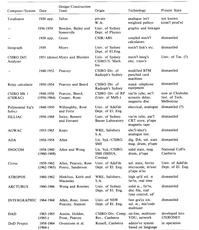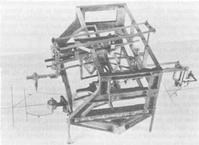


Chapter 8
I Part 1: Communications
II Epilogue
III Part 2: Early Australian Computers And Computing
i Instruments and calculators
ii The transition to the computer, 1945 to 1951
iii The first computers, 1951 to 1956
iv Concentration on large-scale systems, 1958 to 1963
v Software and microelectronics, after 1965
vi Industry, education and the computing fraternity
IV Acknowledgements
References
Index
Search
Help
Contact us

Instruments and calculators
The early period, that of the 1920s and 30s which preceded the advent of the computer proper, was concerned with the development and use of special purpose instruments and digital calculators of relatively slow speed and capability. Instruments were devised for special purposes while digital calculators, like the range of Hollerith and Powers punched card machines, desk calculators and accounting machines, were commercially developed overseas and marketed here.
Australia's innovations in the devising and use of instruments were the totalisator (Julius, G. A., 1920) which relied upon the use of weighted multiple pulleys, sophisticated graphical techniques (Bowden, A. T., 1936, and Bailey, V. A. and Somerville, J. M., 1938) and a development of the mechanical integraph for the graphical solution of commonly occurring differential equations of second order (Myers, D. M., 1939). That as many as 23 patents relating to calculating devices were issued by the Australian Patents Office between 1909 and 1940 is an indication of the inventive interest in calculating devices in Australia during the period.

Although there were none of the larger instruments like the multi-integrator differential analyser (DA), linear equation solvers, harmonic analysers or network analysers in Australia then, some of the local scientific community were becoming acquainted with such instruments overseas and were to return to put their new knowledge to use. Such was D. M. Myers, who worked with D. R. Hartree and A. Porter during 1935 and 1936, using the eight-integrator mechanical DA. He returned to Sydney to become Chief of the Council for Scientific and Industrial Research's (CSIR) Division of Electrotechnology (DE). During the Second World War, he became involved in the development of accurate prediction methods for coastal defence gunnery which led to the '103 Converter' which had firing errors down to about 25 yards. Six of these were built and installed locally, in New Zealand and Singapore. Later, more accurate radars with magslip or servo transmission of variables replaced the Converter.
Australia's Second World War need for involvement in the development and manufacture of radar systems and the production of microwave vacuum tube technology led to the establishment by CSIR of its Division of Radiophysics (RP) sited, with other divisions, in the grounds of Sydney University. This Division was led by E. G. Bowen, who had been one of the pioneers of radar at Bawdsey in the UK and J. L. Pawsey, one of the pioneers of high definition television at EMI, Hayes, Middlesex. By the end of the war the Division was in a position to use its experience in radar pulse techniques towards electronic computing.
Organisations in Australian Science at Work - Australian Patents Office; CSIRO Division of Electrotechnology (D.E.); CSIRO Division of Radio Physics; University of Adelaide. Department of Electrical Engineering
People in Bright Sparcs - Allen, M. W.; Bowden, A. T; Bowen, E. G.; Julius, Sir George; Myers, D. M.; Pawsey, J. L.; Pearcey, T; Penny, J. P.; Rose, G. A.; Sanderson, J. G.
 |
Australian Academy of Technological Sciences and Engineering |  |
© 1988 Print Edition pages 613 - 615, Online Edition 2000
Published by Australian Science and Technology Heritage Centre, using the Web Academic Resource Publisher
http://www.austehc.unimelb.edu.au/tia/586.html